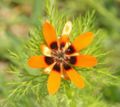Adonis
| Adonis subsp. var. | ||||||||||||||||||||||||||||||||||||||||||||||||||||||||
|---|---|---|---|---|---|---|---|---|---|---|---|---|---|---|---|---|---|---|---|---|---|---|---|---|---|---|---|---|---|---|---|---|---|---|---|---|---|---|---|---|---|---|---|---|---|---|---|---|---|---|---|---|---|---|---|---|

|
|
| ||||||||||||||||||||||||||||||||||||||||||||||||||||||
| ||||||||||||||||||||||||||||||||||||||||||||||||||||||||
Adonis is a genus of about 20-30 species of flowering plants of the family Ranunculaceae, native to Europe and Asia.
The species grow to 10-40 cm in height, with feathery, finely divided leaves. Their flowers are red, yellow or orange and have 5-30 petals.
They are cultivated for use in gardens, and have been introduced to North America. Adonis spp. contain poisonous chemicals similar to those found in many other genera in the Ranunculaceae.
| Standard Cyclopedia of Horticulture |
|---|
|
Adonis (a favorite of Venus, after his death changed into a flower). Ranunculaceae. Hardy annual and perennial herbs planted for their showy flowers. Flowers solitary, terminal; petals 5-16, yellow or red; carpels many: st. about 1 ft. high, very leafy: lvs. alternate, cut into very narrow divisions: fr. an achene. The culture is simple in any good soil, light moist earth preferred. They thrive in full sun or partial shade; the perennial species well suited for rockwork and borders. Only a few well-known species, natives of temperate regions of Europe and Asia; perhaps 20 in the genus. Annuals are propagated by the seeds, which are slow-germinating; the freshest seed is sown in autumn or earliest spring. Perennials may, in like manner, be grown from seed and come to flower the first season, but division of the roots is to be preferred as the flowers are then more abundant. Very early spring is the best time for dividing.
|
Cultivation
Propagation
Pests and diseases
Species
- Selected species
- Adonis aestivalis - summer pheasant's-eye
- Adonis aleppica
- Adonis amurensis - Far East Amur adonis
- Adonis annua (syn. A. autumnalis) - pheasant's-eye or blooddrops
- Adonis bobroviana
- Adonis chrysocyathus
- Adonis coerulea
- Adonis cyllenea
- Adonis davidii
- Adonis dentata
- Adonis distorta
- Adonis flammea
- Adonis microcarpa
- Adonis nepalensis
- Adonis palaestina
- Adonis pyrenaica from the Pyrenees, has thick foliage and large golden yellow flowers in early summer.
- Adonis ramosa
- Adonis sibirica
- Adonis sutchuenensis
- Adonis tianschanica
- Adonis vernalis - spring pheasant's-eye
- Adonis volgensis
Gallery
-
Adonis aestivalis,
summer pheasant's-eye -
Adonis amurensis,
Far East Amur adonis -
Adonis annua,
pheasant's-eye -
Adonis flammea
-
Adonis microcarpa
-
Adonis ramosa
-
Adonis vernalis,
spring pheasant's-eye
References
External links
- w:Adonis. Some of the material on this page may be from Wikipedia, under the Creative Commons license.
- Adonis QR Code (Size 50, 100, 200, 500)







